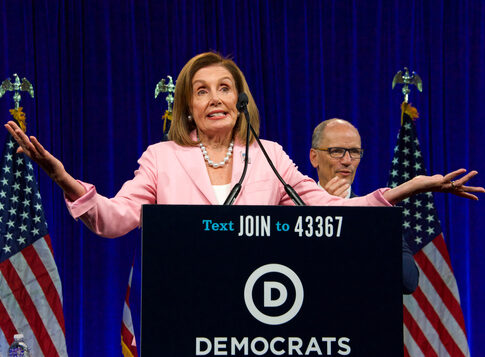White House Press Secretary Karoline Leavitt delivered a powerful rebuke of Democratic politicians, exposing what she characterized as blatant hypocrisy on tariff policies. Leavitt’s briefing served as a pointed reminder that current Democratic objections contradict their long-standing positions on protecting American jobs and addressing trade imbalances with China. How have Democratic positions on China trade policies evolved since Nancy Pelosi’s 1996 statements?
Democrats’ Historical Support for Tariffs
White House Press Secretary Karoline Leavitt took Democrats to task during Tuesday’s press briefing, highlighting what she described as their hypocritical stance on President Trump’s tariff policies. The briefing came just hours before Trump’s newly announced 104% tariffs on Chinese goods were set to take effect at midnight, a response to China’s retaliatory measures against initial U.S. tariffs.
Leavitt specifically cited Nancy Pelosi’s 1996 congressional speech in which the former Speaker demanded action against China. “How far does China have to go? How much more repression, how big a trade deficit and loss of jobs for the American worker, and how much more dangerous proliferation has to exist before members of this House of Representatives will say, ‘I will not endorse the status quo?'” Pelosi had passionately argued nearly three decades ago.
The press secretary contrasted this with Pelosi’s recent statement that “Donald Trump’s reckless tariffs will cause chaos in our economy, raise prices for consumers, and hurt hardworking American families.” This stark reversal in position formed the cornerstone of Leavitt’s argument about Democratic inconsistency in trade policy.
1) 1996 Nancy Pelosi encourages all of Congress to back reciprocal tariffs
2) 2008 Bernie Sanders wants tariffs, says jobs are going overseas
3) 2018 Barack Obama calls for reciprocal tariffs
4) 1988 Donald Trump says foreign countries must pay tariffs
Only 1 hasn’t sold out pic.twitter.com/6jqXqaYALC
— Wall Street Apes (@WallStreetApes) April 4, 2025
Trump’s Tariff Strategy Explained
President Trump announced the initial 34% tariffs against China and other trading partners during the “Make America Wealthy Again Event” on April 2, 2025. The administration framed these measures as necessary to address long-standing trade imbalances that have disadvantaged American workers and manufacturers for decades.
China’s subsequent retaliatory tariffs prompted Trump to escalate with the upcoming 104% tariff increase. Leavitt emphasized that these actions fulfill campaign promises to restore American manufacturing jobs and address unfair trade practices that previous administrations acknowledged but failed to effectively confront.
🚨TRUMP: “Right now China is paying a 104% tariff. It sounds ridiculous but they charged us for many items 100-125%. Many countries have. They’ve ripped us off left and right. Now it’s our turn to do the rippin’!”pic.twitter.com/3DkJImDtow
— Sara Rose 🇺🇸🌹 (@saras76) April 9, 2025
Bipartisan History of China Trade Concerns
The press briefing highlighted additional historical statements from prominent Democrats, including Chuck Schumer. “These are the kinds of records the American people don’t want us to be breaking. The administration needs to move beyond words, take action now to reverse a trend that threatens our prospects for future economic growth,” Schumer had previously said regarding trade deficits with China.
Leavitt argued that President Trump is now taking precisely the action that Democrats once called for but currently oppose. She characterized the president’s tariff strategy as a direct response to concerns voiced by politicians across the political spectrum for decades, suggesting that opposition now stems from political calculation rather than policy disagreement.
Economic advisors to the Trump administration have projected that these tariffs will strengthen domestic manufacturing and create jobs in key industrial sectors. Critics from both political parties have expressed concern about potential price increases for American consumers, though the administration maintains that long-term economic benefits will outweigh short-term adjustments in the marketplace.


